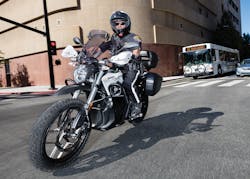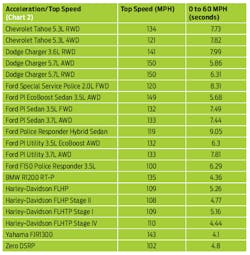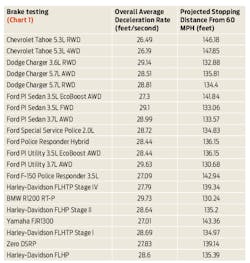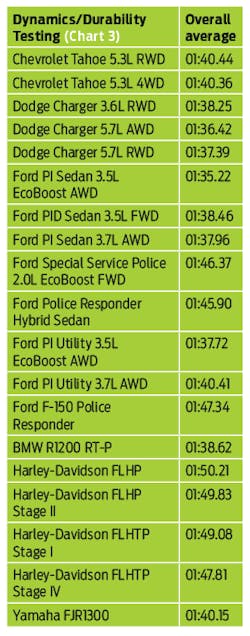Law Enforcement Vehicles Get Faster, Safer and Greener
Each September, Michigan State Police holds its annual vehicle testing at Grattan Raceway, testing the industry’s latest vehicle and motorcycle models. This year’s competitors in the vehicle category included submissions from Ford, FCA (Dodge) and General Motors. The motorcycle division included BMW, Harley-Davidson, Yamaha and Zero.
The Dodge Charger 5.7L AWD and Dodge Charger 5.7L RWD tied for the top speed of 150 mph while the Yamaha FJR1300 had the top speed of 143 mph in the motorcycle category [see Chart 2]. The Ford Police Interceptor Sedan retained its title for the sixth straight year as the overall quickest police vehicle tested from 0-60 mph. These are just a few of the many results—to view all of MSP’s collected data, visit its website at www.michigan.gov/msp.
McCarthy has been involved in the Michigan State Police Vehicle Testing for a decade now and says that each year he sees more improvements on the vehicles and motorcycles that are so paramount to law enforcement.
Performance and efficiency
The future of having both performance and efficiency in a patrol vehicle is here. This year Ford tested its 2019 Fusion-based Police Responder Hybrid Sedan, which has a projected EPA-estimated rating of 40 mpg city and 36 mpg highway for a combined rating of 38 mpg (final EPA-estimated ratings not yet available). “We see hybridization as a great solution, especially for the police duty cycle, and as they gain acceptance, we’d expect share of hybrids to grow,” says Stephen Tyler, Ford Police Brand Marketing Manager.
Though the Police Responder Hybrid Sedan missed the MSP purchasing spec in the top speed category by one mile per hour, McCarthy says that every department’s needs and purchasing specifications are completely different. “My department has a large function of freeway patrol, so we are more concerned being able to catch up to a car that goes by us going 100 mph than a municipal agency may be.” There are a lot of benefits to hybrid vehicles, he notes. “We spend a lot of time idling in our patrol car because we have so much electronic equipment. The hybrid vehicle has such a large battery capacity in them that they can be powered off of the battery with the car stopped, without the gasoline engine running until the voltage drops to a certain level and then the car fires up and charges the batteries again.” This results in lower emissions and money saved in gasoline costs.
This year Zero Motorcycles submitted its all-electric DSRP. “The designation of the ‘R’ is our high performance vehicle,” says Kevin Hartman, fleet and authority sales director with Zero Motorcycles. “It’s a bigger motor and bigger controller. It has a higher top speed and is faster off-the-line.” Hartman says the motorcycle performed in the middle of the pack, doing exactly what a law enforcement motorcycle needs to do, plus more. The DSRP is 30 percent off road, 70 percent on road, says Hartman, filling a niche in the law enforcement industry. It also is 100 percent electric. “We say it’s a penny per mile to operate our motorcycle,” says Hartman.
McCarthy notes that most, if not all, vehicle manufacturers are looking at alternative power sources whether it’s hybrid gas and electric or strictly electric. “I think our national awareness is going to drive alternative powers in the police industry as far as municipal policing goes, so where you have slow speeds and idling time, those technologies are going to be great for improving our carbon footprint,” he says.
The need for speed…and safety
Vehicle manufacturers are not only putting attention towards efficiency, they’re also placing an emphasis on safety. GM Fleet announced that Chevrolet is adding new safety features and options to the 2018 Tahoe Police Pursuit Vehicle (PPV) for the 2018 model year, including technologies designed to help reduce potential crash speeds or help avoid a crash all together. And Dodge extended its Officer Protection Package—which uses ParkSense rear park assist system, ParkView rear backup camera, and Rear Cross Path detection to alert officers when movement at the rear of the vehicle is detected—to the 2018 Dodge Charger Pursuit.
McCarthy notes that in his 10 years working on the MSP vehicle testing, safety is something that is continuously being improved. “If you go back and look at the history of the vehicle testing, as far as braking effort went, the worst car today brakes better than the best car 10 years ago,” he says. “So the braking has become greatly enhanced. We have much better braking, because everyone saw that it needed to be improved. When police are given fast speeds they have to be given good braking so the cars aren’t a danger to be driven.” [see preliminary brake testing results in Chart 1]
McCarthy also sees manufacturers offering supplemental ballistic door panels to protect officers, though that feature was not included in MSP testing.
Down the road
The patrol car is indeed getting faster and safer, and more alternative fuel options are certainly on the horizon. But vehicle trends will continuously change. “Autonomous technologies are the big buzz in the car world right now,” says McCarthy. “So the interesting thing will be how quickly autonomous technology rolls out to the field, how quickly the roadway infrastructures can be brought up to be autonomous compatible and how the role of police changes once cars start driving themselves.” He doesn’t see this technology happening during his career, but McCarthy predicts it will be on the horizon perhaps 10 or 20 years from now.
For now, law enforcement agencies will continue to turn to results of tests like the annual Michigan State Police Vehicle Test in order to find the best patrol vehicle or motorcycle suited for their needs.
Editor’s Note: All results listed in the article as of press time are preliminary and are subject to change upon verification of data.

Adrienne Zimmer | Editor
Adrienne Zimmer was the Editor of Law Enforcement Technology magazine, a monthly business-to-business publication that covers technology trends and best practices for public safety managers from 2017 to 2019. LET is part of Officer Media Group, which also publishes Law Enforcement Product News and Officer.com. Adrienne has been in publishing since 2013.






